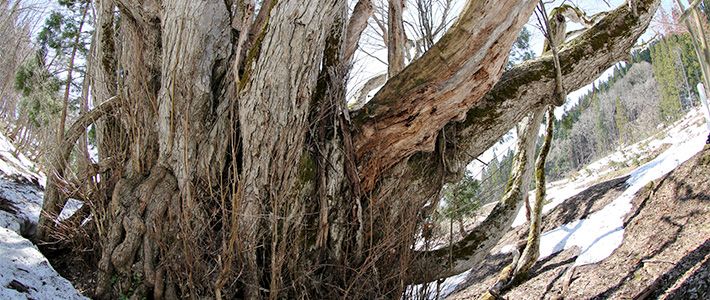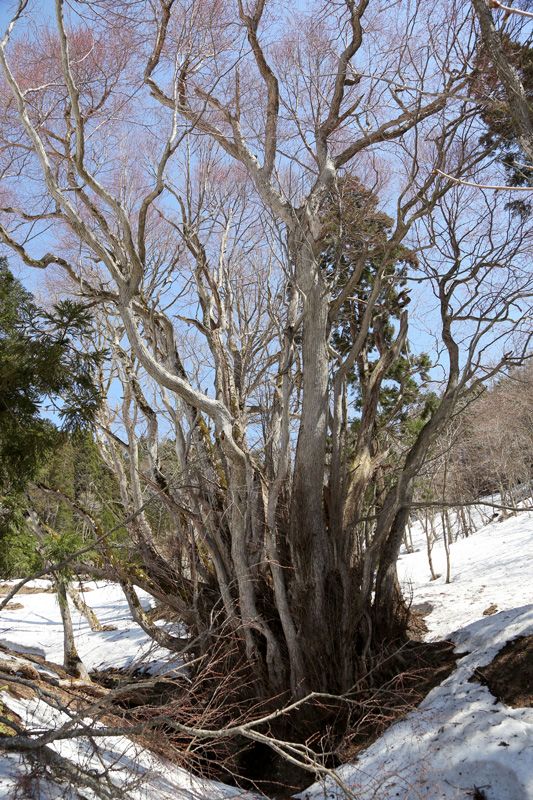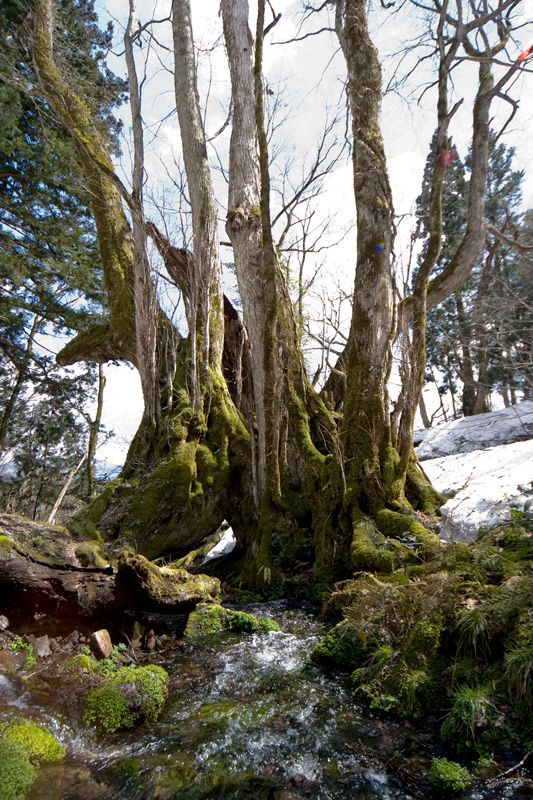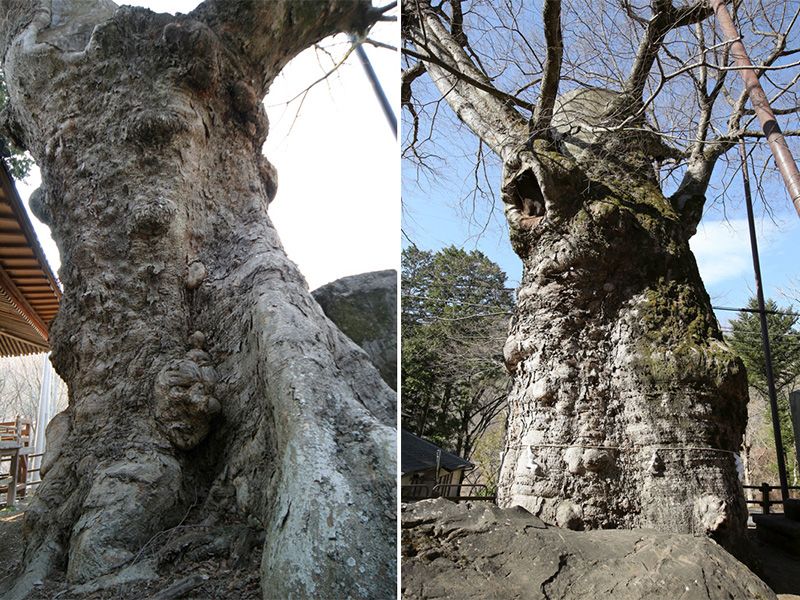
Japan’s Ancient Giants of the Forest
Season of Renewal: Three Old-Growth Trees in Early Spring
Guideto Japan
Culture- English
- 日本語
- 简体字
- 繁體字
- Français
- Español
- العربية
- Русский
After the coldest, darkest days of winter have passed, trees begin to awaken and summon energy stored over the winter. Even as snow lingers on the ground, the lengthening rays of the afternoon sun warm and gently coax leaf and flower buds open, gradually festooning long, bare limbs in spring colors.
Japan has many specimens of deciduous species like zelkova and gingko that have grown to be towering kyoju, or old-growth trees. One of the most representative types is the katsura, a native plant whose red-tinged flower and leaf buds lend a vernal air to the surrounding environment.
As winter slowly retreats, we visit three old-growth trees on the cusp of spring.
The Thousand-Limbed Chōkai Katsura (Akita Prefecture)
Variety: Katsura (Cercidiphyllum japonicum)
Location: Kurisawa, Chōkai, Yurihonjō, Akita Prefecture, 015-0503
Trunk circumference: 17.6 m; height: 40 m; age 800 years
Designated a prefectural natural monument
Size: ★★★★★
Vigor: ★★★★★
Shape: ★★★★
Crown spread: ★★★★
Grandeur: ★★★★
This impressive katsura, thought to be one of the largest in Japan, is hidden deep within the mountains of southern Akita Prefecture. Like many older katsura, its original trunk has long ago disappeared and been replaced by a robust tangle of offshoots that have twisted into a sinewy new bole. Gazing on the mesh of limbs, it is easy to see how the burly kyoju came by its name.
When I first visited the tree in mid-April its crown was ablaze with blossoms. Similar to the cherry, katsura bloom prior to putting on foliage, and to see the tree, which stands 40 meters tall, covered in maroon flowers was an eye-popping spectacle. Katsura offer an equally impressive display of red when their leaves appear. Young foliage changes quickly, though, and peak viewing lasts a mere two days. For the lucky visitor, it is a moving sight to behold.
At 17.6 meters around, the tree is among the top three katsura in Japan in terms of girth. In 1989 it was included on a list of Japan’s 100 most famous old-growth trees. The local community has in recent years developed the surrounding area in an attempt to attract tourism, including improving the access road and felling adjacent trees. Visitors who make the climb up the hillside can now admire the katsura free of obstructions, and on clear days will be doubly rewarded with a spectacular view of Mount Chōkai towering to the south.
The Wachi Grand Katsura (Hyōgo Prefecture)
Variety: Katsura (Cercidiphyllum japonicum)
Location: 709 Wachi, Muraoka, Kami, Mikata, Hyōgo Prefecture, 667-1347
Trunk circumference: 15.35 m; height: 39 m; age: 1,000 years
Designated a prefectural natural monument
Size: ★★★★
Vigor: ★★★
Shape: ★★★★
Crown spread: ★★
Grandeur: ★★★★
Katsura prefer moist environs and commonly grow near brooks, rivers, and other bodies of water. This ancient specimen, located inside the Tajima Highlands Botanical Gardens in northern Hyōgo Prefecture, is rare in that it straddles a spring, giving the impression that it is guarding the bubbling stream. Its position over the meter-wide flow has nurtured a thick blanket of moss that shrouds its roots, enhancing the stunning scene.
While the march of time has claimed the aged katsura’s central trunk and many of its offshoots, the tree retains its vigor and continues to tower robustly over the landscape. When I visited there was still snow on the ground, but the sun was shining and the tree was mere days away from coming alive in new foliage. Listening to the gurgle of the stream as it flowed beneath the katsura made for a wonderfully relaxing and magical moment in the woods.
Visitors should be certain to take in the surrounding scenery during their visit, timing it with the blossoming season if possible. I also recommend enjoying a draught from the stream. It is registered on a modern list of Japan’s 100 tastiest spring waters. Its crisp, clear flow can be enjoyed from a bamboo pipe at the end of the wooden causeway flanking the ancient katsura.
The Grand Keyaki of Negoya Shrine
Variety: Zelkova (keyaki) (Zelkova serrata)
Location: 5336 Azanegoya, Egusa, Sutama, Hokuto, Yamanashi Prefecture, 408-0103
Tagi (left), trunk circumference: 11.2 m; height: 20 m; age: 1,000 years
Hatagi (right), trunk circumference: 12 m; height: 21 m; age: 1,000 years
Designated national natural monuments
Size: ★★★★★
Vigor: ★★
Shape: ★★★
Crown spread: ★★
Grandeur: ★★★★
It has been a custom since ancient times to plant a pair of zelkova, keyaki in Japanese, at the front of the sandō, the walkway that leads to the haiden (hall of worship) at a Shintō shrine. Many of these plants have survived the centuries and grown to be towering kyoju.
The grand keyaki of the Negoya Shrine are distinguished from similar pairs of zelkova, which are often thought of as wedded couples, by their girth. Both boast trunk circumferences of more than 10 meters and are possibly the only dual specimens of this size in Japan. During feudal times a castle associated with the powerful Takeda clan stood on a nearby hill and the influential lord Takeda Shingen (1521–1573) is said to have passed between the trees, only 500 years old then, to pray at the Negoya Shrine.
The trees, standing to the right and left of the sandō, respectively, are known as hatagi and tagi. Despite their proximity the zelkova tend to put on foliage at different times. If hatagi buds first, it is thought to portend a bumper year for field crops, while if tagi is earlier, this augurs a good rice harvest. Of equal cultural interest are the boulders that set next to each ancient keyaki. These are remnants of a time when people in the region venerated large stones as sacred and indicate that an ancient follower of this faith planted the trees.
Photos taken early last century show the two kyoju in splendid form, standing tall and their robust crowns spread wide. However, a fire in 1968 damaged the pair. Since the tragic event a large hollow has developed in hatagi’s trunk and tagi’s bole has snapped and also developed a hole. Until around two decades ago a few burly limbs were all that remained to remind visitors of the trees’ earlier impressive forms.
Around 10 years ago, though, a tree surgeon treated the damaged kyoju, including changing the soil around the roots and installing a fence to keep foot traffic from compacting the ground. The result has been a significant increase in new growth and overall improvement in the health and appearance of the two zelkova.
(Originally published in Japanese on February 21, 2017. Photos and text by Takahashi Hiroshi.)

